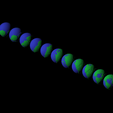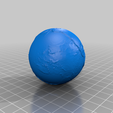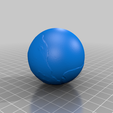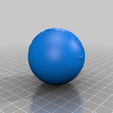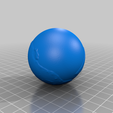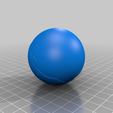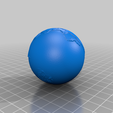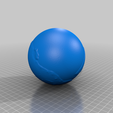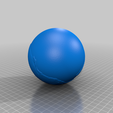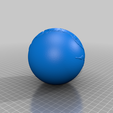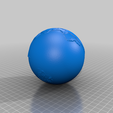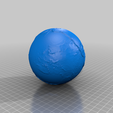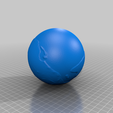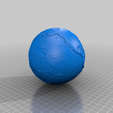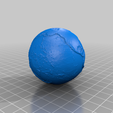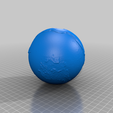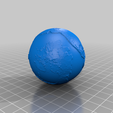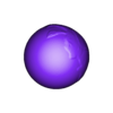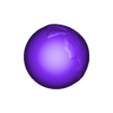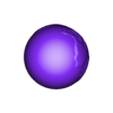The idea of this post was suggested by Sebastian Steinig. I plotted the geography of the Earth several past ages, from the supplementary data of Scotese and Wright (2018). In that work, there are 117 Earths mapped from 540 million years ago (Mya) to the present, every five million years. They are too many models to made them in every scale. I reduced them to 13 ages, near to well known event like massive extinction events. The method I used for plotting this models is the same as my others astronomical models. The height of the topography in every case is exaggerated 30 times over a fixed radius. The chosen ages were associated with the next events:
20 Mya: This age was close to the start of the Miocene. In this age most of modern mammals clades had established on its ecological niches. The Indian subcontinent was in route to collide with Asia.
50 Mya: This age was during the Eocene in which the world's climate cool down to modern temperatures. This was triggered by the Azolla event; in which Arctic Ocean isolated from the rest of the water masses, was desalinized by the irrigation of the afluent rivers. A small freshwater plant of the genus Azolla spreed on the entire warmer Arctic Ocean reducing the global CO2 levels and therefore the greenhouse effect. Laurassia splited into modern day's northern continents.
65 Mya: This is the age approximately of the famous K-T event; in which all non-avian dinosaurs, plesiosaurs, mossasaurs, the remaining pterosaurs, many clades of mammals, ammonites and several other existing groups were wiped off. This marks the end of the Mesozoic and the start of the Cenozoic eras. The exact cause of it is still discussed, but it is very likely to be the result of the impact of a 10 km wide asteroid, and happened within a very narrow window of time.
95 Mya: This is close to a poorly known extinction event between the Cenomanian and Turonian ages during the Cretaceous period, in which the oxygen levels of the oceans dropped; and disappeared several marine megafaunal clades, like ichthyosaurs and pliosaurs. Land fauna should have been unaffected, but there are many non-avian dinosaur clades that did not pass this boundary: megalosaurs, carnosaurs, stegosaurs and non-titanosaur sauropods; as well as all but the last pterosaur clades. After this age, the environment was quite similar to present, with modern birds, fish, turtles, crocodiles, lepidosaurs and magnoliophite plants widespreading all around.
145 Mya: The transition from the Jurassic to the Cretaceous period was marked by an extinction event, however this event is still poorly defined, as all mayor groups of biota existed, and were very similar, during Late Jurassic and Early Cretaceous. Gondwana started to fragmentate into the modern south hemisphere continents.
200 Mya: At this age happened the Triassic - Jurassic extinction event. It was one of the major one, with the lost of most non mammalian synapsids, raisuchids, phytosaurs and other groups. This left free way to the on going dinosaur expansion. At this point, the Pangea supercontinent started to brake up into Gondwana and Laurasia.
250 Mya: Considered the most severe extinction. It marks the end of the Permian period and the start of the Mesozoic; 96% of the existing lifeforms died off. It ocurred in various stages, taking around 10 million years. The trilobites and anapsids (as a paraphileptic group) went extinct at this time. The most likely cause is the eruption of the Siberian Traps.
305 Mya: It took place the Carboniferous rainforest collapse, in which the then new tree-like plants in primitive forests across the entire Pangaea, entered in a runaway collapse. At first, the forests were fragmented into "islands", where primitive complex land life evolved isolated, but it ended in a total depletion of rainforest. Following this event, totally different kind of coal producing plant recovered landmasses.
360 Mya: The end of the Devonian to the start of Carboniferous periods. During this age, the apparition of complex land trees makes the oxygen atmospheric levels to increase to higher levels than today; allowing to early arthropods to grow to gigantic sizes when compared with modern ones. Fish also diversificated during this period, while primitive placoderms disappeared. The Devonian continents, Gondwana (similar to the later one) and Euramerica were in course to collide and form Pangaea supercontinent. The Iapetus Ocean shrinked.
420 Mya: The end of the Silurian period. This period was relatively short. The first land animals appeared. The continent Baltica (eastern Europe) collided with Laurentia (Northamerica), forming Euramerica.
445 Mya: It happened the Ordovician - Silurian extinction events, a serie of extinctions that wipe almost 50% of the existing families and genera.
485 Mya: The Cambrian–Ordovician extinction event took place. After this, occured the great Ordovician biodiversification, in which several extant and now extinct mayor phylum evolved. It has been speculated that this event was triggered by a meteorite shower around this age.
540 Mya: The start of the Phanerozoic Eon, which extends to the present, and the Cambrian period. It took place the Cambrian Explosion, in which all major animal phyla started appearing. The supercontinent Pannotia splited into Laurentia, Siberia, Baltica and Gondwana. Previously to that, Pannotia was assembled from the parts from Rodinia, another supercontinent. There is a supercontinent cycle that happened every 200 - 500 million years. However before Rodinia, it is discussed if it were or not previous cycles. At one view, there were at least 4 previous cycles, Vaalvara, Ur, Kenorland and Columbia (older to younger). The other view argues that previous to 600 Mya, there was only one stable supercontinent in a process called "lid tectonics"
The file's names explained: name_1_x_10_y.stl is 1 : x * 10y. So _1_6_10_7 is 1:600000000 or one in 60 million.
References
PaleoDEM
Surf to STL function for MATLAB
Other astronomical objects
Object
Scale [1:x]
K = 103 (thousand)M = 106 (million)G = 109 (billion)
Image
Inner Solar System
Mercury
20M, 60M,
120M
Venus
60M,
120M,
250M
Earth
60M,
120M,
250M
Luna
10M, 20M,
60M
Mars
20M, 60M,
120M
Phobos and Deimos
200K,
500K
Artificial
Salyut 7
40, 48, 80, 160
Near Earth Asteroids
Moshup and Squannit
8K,
20K,
40K
Ra-Shalom
20K,
40K
Castalia
8K,
20K,
40K
Bacchus
8K,
20K
Bennu
3K,
8K
Ryugu
3K, 8K,
20K
Geographos
40K,
80K
Phaethon
40K,
80K
Itokawa
3K,
8K
Eros
80K, 200K,
500K
Nereus
3K,
8K
Mithra
20K,
40K
Golevka
8K
Toutatis
40K,
80K
Main Asteroid Belt
Gaspra
200K
Annefrank
<a href="/tato_713/collections/one-in-forty-thousand-sc

/https://fbi.cults3d.com/uploaders/15008782/illustration-file/4393f141-e661-49d1-b180-f182260cb1b6/ancient_earths.png)
